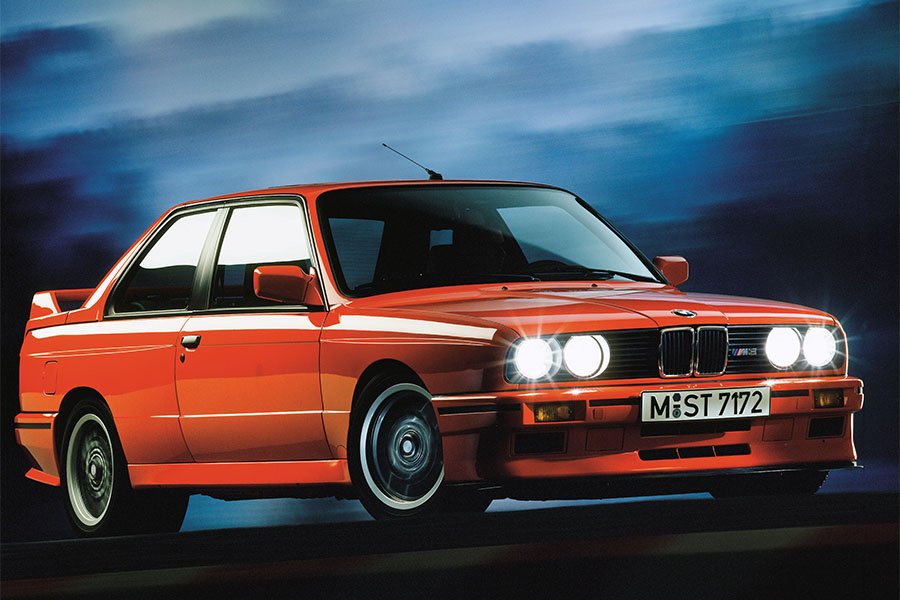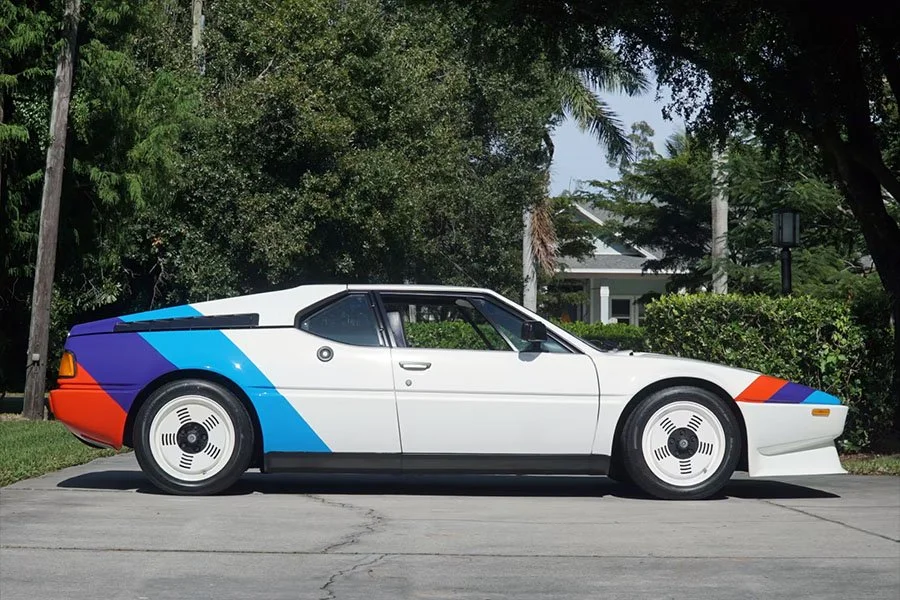Guide: BMW E30 M3 2.5 Sport Evolution (Evolution 3) - a Historical & Technical Appraisal
/BACKGROUND
Unveiled in March of 1987 and ‘88 respectively, BMW’s first pair of E30 M3 Evolutions catapulted the Bavarian firm to great success in Group A Touring Car racing.
The Evolution rule allowed manufacturers to build further uprated variants of the already homologated base car every twelve months so long as 500 road going examples were produced ahead of time.
Despite its Division 2 status (the result of an under 2.5-litre engine), the first M3 Evolution had recorded four outright victories in the 1987 World Touring Car Championship and taken class honours on all but one occasion (when the BMWs were excluded from the opening race of the year). Schnitzer’s Roberto Ravaglia was crowned 1987 Driver’s Champion but Ford team Eggenberger Motorsport claimed that year’s Entrant’s title.
In the 1987 European Touring Car Championship (ETCC), the M3 won six of seven races outright and took a clean sweep of the Division 2 honours. Linder Rennsport’s Winfried Vogt secured the 1987 Driver’s title and BMW were crowned Manufacturer’s champions.
Elsewhere, Eric van de Poele driving for the Zakspeed BMW Junior Team became the 1987 DTM champion as the M3 won five out of ten races.
For 1988, BMW switched to the more extensively modified Evolution 2 which ushered in less weight, more power and improved aerodynamics.
Although the World Touring Car Championship was no more, the European series soldiered on for one final season. 1988 saw the M3 win three ETCC rounds outright and secure Division 2 honours following class victories in all eleven rounds. Schnitzer’s Roberto Ravaglia claimed the Driver’s title but BMW missed out to Ford in the Car’s championship.
As the ETCC struggled, the DTM blossomed with Mercedes taking the challenge to BMW and Ford with their Division 2 190 E 2.3-16.
BMW won a third of the 21 DTM races held in 1988 (but no titles) although a repeat number of victories in 1989 saw Schnitzer’s Johnny Cecotto crowned champion.
BMW’s 1989 success marked another high point for the E30 M3 despite the increasingly serious challenge from Mercedes who had campaigned the first Evolution of their ageing 190 E that season.
For 1990, Mercedes were known to have a much more radical second Evolution in the pipeline and Audi were set to join the DTM too so, keen to see off their domestic rivals, BMW created an overdue third Evolution of the E30 M3: the M3 Sport Evolution.
Announced in December 1989, the Sport Evolution was the most extensively modified E30 M3 yet as BMW Motorsport looked to exploit the Division 2 class regulations to their limit and nullify the challenge from Mercedes and Audi.
ENGINE / TRANSMISSION
Uniquely, the Sport Evolution was the only E30 not to use a 2302cc version of the fabled inline four cylinder S14 engine. Instead, this final iteration featured a power unit taken out to 2467cc (a gain of 165cc).
Each cylinder bore was enlarged from 93.4mm to 95mm. Meanwhile, stroke was lengthened from 84mm to 97mm which necessitated the installation of a unique long throw crankshaft. Special nozzles were also installed that sprayed oil under the pistons to keep them cool.
Other new equipment included more aggressive camshafts, larger inlet and exhaust valves (the latter now sodium-cooled) and a big bore exhaust manifold.
Unlike the Evolution 2 motor which featured a white M-striped cam cover and intake plenum, the Sport Evolution’s engine returned to a conventional black finish albeit with distinctive new red-capped spark plug leads.
The compression ratio was reduced from 11.0:1 to 10.2:1 and every engine was equipped with a catalytic converter regardless of the car’s final destination.
The Evolution 2’s more efficient air intake tube and lightened flywheel were carried over and Bosch’s Motronic engine management was optimised for this latest application.
Peak output was 238bhp at 7000rpm and 177lb-ft at 4750rpm.
For comparison, the outgoing Evolution 2 had pumped out 220bhp at 6750rpm and 181lb-ft at 4750rpm.
The rest of the Sport Evolution’s engine characteristics were largely unchanged; it ran the M10-derived cast-iron block with a shortened four valve light alloy DOHC head developed from the six cylinder M88 and S38 motors. Individual throttle plates were installed for each cylinder along with siamesed pistons and mechanical instead of hydraulic lifters. An oil cooler was located behind the front spoiler.
Transmission was as per the Evolution 2: a Getrag 265 close-ratio five-speed gearbox (with dogleg first), a hydraulic clutch, limited-slip differential with 25% locking factor and 3.15:1 final drive ratio.
BODYWORK
Although it looked little changed, the Sport Evolution’s bodywork came in for a fair degree of attention too.
Adjustable front and rear spoilers were homologated with the front chin splitter and rear flap offering a choice of three settings: Monza (low downforce), Normal and Nurburgring (high downforce).
To save a few kilos, BMW Motorsport installed even thinner side and rear glass plus a lightweight trunk lid and bumpers.
To improve aerodynamics, the front grille vanes came with sealed gaps.
Like the Evolution 2, this latest variant once again featured brake cooling ducts instead of fog lights.
Almost impossible to spot were the modified front fenders which BMW Motorsport needed in order to run 18-inch diameter wheels in race trim.
A choice of two exterior colours was offered: Jet Black with red bumper inserts or Brilliant Red with black bumper inserts.
All the M3-specific body parts (everything bar the hood) were fabricated from SMC composite. To improve rigidity, both the front and rear windscreens were bonded in place as per every M3. Similarly, blacked out Shadowline trim was standard and M3 badges were mounted on the front grille and tailgate.
INTERIOR
The most striking new feature of the Sport Evolution’s cockpit was its new high-backed Recaro front seats trimmed in Anthracite fabric with striped M cloth centres that matched the rear seats and door panels. At additional cost, customers could specify Black Nappa leather with Motorsport tricolour labels.
Other previously unseen features included a set of red seatbelts and dark grey alcantara suede upholstery for the M-Tec II steering wheel rim, handbrake lever and gear gaiter. A numbered Sport Evolution plaque was located on the centre console and an illuminated gear knob was imported from the from the Johnny Cecotto / Roberto Ravaglia limited edition Evolution 1s. M3-branded sill plates from the Evolution 2 were fitted as well.
In standard trim these cars came without electric windows or a map reading light although electric door mirrors were retained.
Red needled VDO instrumentation was as per every other M3. It comprised a special 160mph (260kmh) speedometer and 8000rpm rev counter. These two large dials were split by a BMW Motorsport logo and an oil temperature gauge which replaced the economy meter fitted to the rest of the E30 range.
CHASSIS
To provide more focused handling, the Sport Evolution came with stiffer springs and shocks, thicker anti-roll bars, revised steering caster angles and stronger wheel bearings. Ride height was 10mm lower than other M3s.
The same 7.5 x 16-inch BBS cross spoke alloy wheels as fitted to the Evolution 2 were installed (along with identical 225/45 ZR16 tyres) but the wheel centres were now painted Nogaro Silver and the outer rims given a polished effect.
Track was 4mm wider at the front and 6mm wider at the rear.
A smaller 62-litre fuel tank was installed under the rear seats (reduced from 70-litres).
The rest of the chassis set-up was unchanged.
Each car started with a pressed steel two-door bodyshell to which the familiar MacPherson strut / semi-trailing arm suspension layout was added.
A special M3-specific Bosch ABS system was fitted and the brake discs were bigger than on normal E30s: 280mm at the front (ventilated) and 282mm at the rear (solid). Reinforced single piston calipers were sourced from the E28 5-series along with the stub axles.
The power-assisted quick ratio steering rack was unique to the M3.
OPTIONS
Although restricted in terms of paint and upholstery colours, Sport Evolution buyers could have their car equipped with an array of optional extras to include air-conditioning, electric windows, an electric sunroof, an on-board computer, cruise control, headlight wash/wipe, rear head rests, velour floor mats and a choice of audio systems.
WEIGHT / PERFORMANCE
Despite its heavier 2.5-litre engine, weight-saving measures taken elsewhere meant the Sport Evolution officially tipped the scales at an unchanged 1200kg.
Thanks to that additional 18bhp, the 0-62mph time dropped by a tenth-of-a-second (to 6.1) while top speed went from 152mph to 154mph.
PRODUCTION
Although only 500 cars were required, demand was sufficient that 600 examples of the Sport Evolution were completed between December 1989 and March 1990, all of which were left-hand drive.
Group A homologation was approved on March 1st 1990.
COMPETITION HISTORY
The 1990 DTM comprised 22 races over eleven double header weekends.
BMW had four works teams in the championship running up to three cars each while Mercedes were represented by four two-car factory teams. By contrast, the Audi-backed Schmidt Motorsport squad ran just a brace of the new V8 Quattros.
Although BMW took the most wins in 1990 (nine compared to Audi’s eight and Mereceds’ five), the Munich firm’s victories were spread across six different drivers. Schnitzer’s Johnny Cecotto recorded the most with three wins while team-mates Roberto Ravaglia and Emanuele Pirro scored one apiece. Steve Soper took two wins for Bigazzi while Soper’s team-mates Jacques Laffite and Jo Winkelhock recorded one win each.
By contrast, seven of Audi’s wins went to Hans-Joachim Stuck and just one to Walter Rohrl. This inevitably saw Stuck crowned 1990 DTM champion with Cecotto the best-placed BMW representative twelve points back in second.
It was a similar story in 1991 when Audi’s Frank Biela took the DTM title. BMW won seven of the 20 races that year (three for Cecotto, three for Soper and one for Winkelhock) while Audi won eight and Mercedes five. Cecotto was once again the BMW driver that accumulated most points over the course of the season but on this occasion placed fourth in the standings.
1992 was the last year for the DTM with the existing Group A-based regulations.
The 190 E Evolution 2 finally came good for Mercedes who won 16 of that year’s 24 races while BMW took seven and Audi slumped to just a solitary victory. Soper, Cecotto and Ravaglia took a brace of wins each and Winkelhock scored one.
Unsurprisingly, Mercedes drivers dominated the final standings with Klaus Ludwig crowned 1992 champion with Cecotto best of the BMW pilots in a distant fourth.
Outside of the DTM, BMW took victory at the Nurburgring 24 Hours in 1990, ‘91 and ‘92 making it four wins on the bounce for the E30 M3. The 1990 event was won by Altfrid Heger, Jo Winkelhock and Frank Schmickler for Linder Motorsport. In 1991 it was the Schnitzer crew of Kris Nissen, Jo Winkelhock and Armin Hahne that emerged victorious while 1992 saw the Bigazzi squad of Johnny Cecoto, Christian Danner, Jean-Michel Martin and Marc Duez that took the honours.
The E30 M3 also won the Spa 24 Hours in 1990 and 1992. The 1990 event fell to Schnitzer’s Johnny Cecotto, Markus Oestreich and Fabien Giroix whereas Bigazzi claimed the ‘92 win thanks to Steve Soper, Christian Danner and Jean-Michel Martin.
Text copyright: Supercar Nostalgia
Photo copyright: BMW - https://www.bmw.com










































